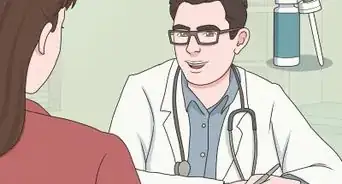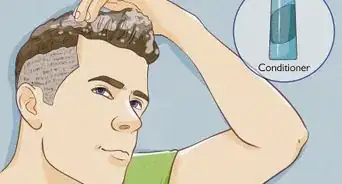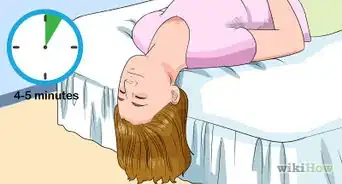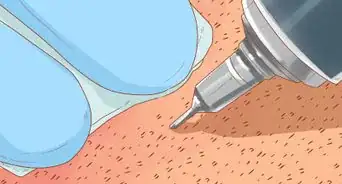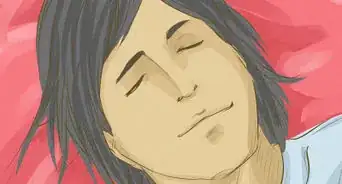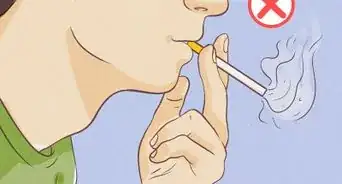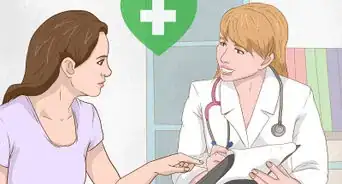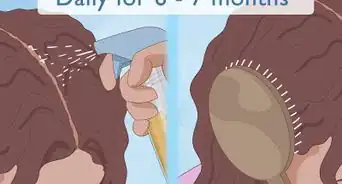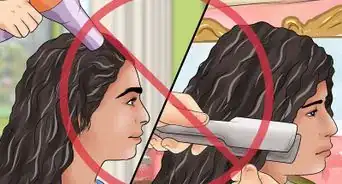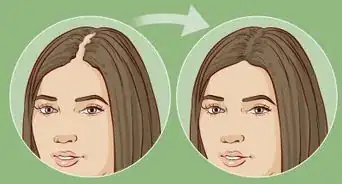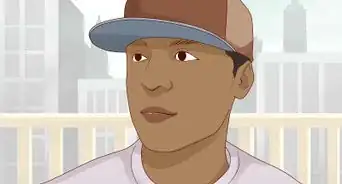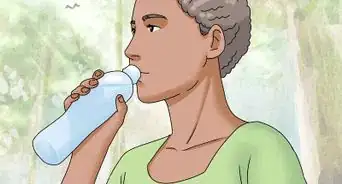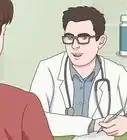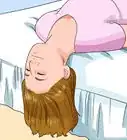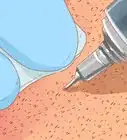This article was co-authored by Courtney Foster. Courtney Foster is a Licensed Cosmetologist, Certified Hair Loss Practitioner, and Cosmetology Educator based out of New York City. Courtney runs Courtney Foster Beauty, LLC and her work has been featured on The Wendy Williams Show, Good Morning America, The Today Show, The Late Show with David Letterman, and in East/West Magazine. She received her Cosmetology License from the State of New York after training at the Empire Beauty School - Manhattan.
This article has been viewed 657,951 times.
Hair loss can occur for many reasons, such as conditions like alopecia, medical treatments, or just from aging. Thinning hair or loss is common for postmenopausal women and can be distressing.[1] Luckily, with simple at-home practices or medical treatments, it’s possible to regrow your hair to a length you like it.
Steps
Promoting Regrowth at Home
-
1Practice good hair care. In some cases, poor hair care can cause hair loss or prevent regrowth. Using good and healthy hair care habits can help you regrow your hair.
-
2Wash your hair regularly and gently. Clean your hair and scalp regularly and in a gentle manner with shampoo and conditioner. This can help you not only regrow your hair, but prevent damage that may cause further hair loss.
- Wash your hair every other day or as little as necessary. Frequent washing can damage your strands.
- Massage shampoo into your scalp and into the length of your hair.
- Rinse by allowing water to flow from your scalp down the ends of your hair. Don’t rub your hair as it rinses, which may cause damage or hair loss.
Advertisement -
3Apply a conditioner to your hair. After you finish washing and rinsing your hair, apply a conditioner along the length of your hair from ends to scalp. This can help prevent further hair loss through damage, including breaking.
- Make sure to use conditioner every time you wash your hair.
-
4Dry your hair cautiously. Drying your hair with towels and hair dryers can cause damage and impede hair growth. Dry your hair with caution to help prevent breakage and promote regrowth.
- After you’ve washed your hair, use a towel to rub or pat your strands dry. Avoid the temptation to wrap your hair in a towel, which can damage your hair and cause breakage.
- Let your hair air dry if possible.
- If you use a hair dryer, use the lowest heat setting. Reducing the number of times per week that you use a hair dryer can also promote hair growth.
-
5Avoid vigorous or frequent brushing and combing. If you brush or comb your hair, try and do this as infrequently and gently as possible. Reducing how often you brush or comb and changing the way in which you do it can help promote hair growth and prevent damage.
- Only brush your hair to style it. It’s a myth that you should brush your hair 100 strokes a day.
- Allow your hair to air dry a bit before brushing or combing after washing.
- Use a wide toothed comb to untangle wet hair. This will cause less damage than a brush.
- If your hair is tangled, remove tangles gently and use a conditioner to help you if necessary.
-
6Style hair wisely. Many people style their hair or use styling products such as curling irons, which are often hotter than a dryer. If you have to style your hair, choose loose styles, avoid heavy products, and use lower heat tools.
- Pulling hair back tightly in ponytails or styles such as cornrows not only can break or damage hair, but also may cause hair loss. Wear your hair pulled back loosely and try different hairstyles every day to allow your hair and scalp to relax.
- Use covered elastic bands to pull back your hair. Rubber can pull and break hair.
- Avoid styling products that are labeled “long lasting hold”. These can damage hair and cause breakage.
- If you use styling tools such as curling irons, flat irons, or hot combs, keep them at the lowest setting.
- If you wear a weave or hair extensions, make sure they are light so that they don’t pull at your hair and scalp.
-
7Use chemical treatments sparingly or not at all. If you chemically treat your hair with color, perms, or relaxants, wait longer between treatments or avoid them altogether if you can. This can not only promote growth, but may also prevent damage and breaking.
- Wait eight to 10 weeks between touch ups.
- Have only one service at a time. If you are having multiple services, wait two weeks in between them.
-
8Protect your hair and scalp from the sun. If you go outside frequently, use a sunscreen or large hat. This can not only protect your strands and scalp from the suns harmful rays, but may help promote hair growth and prevent breakage.
- Any type of wide-brimmed hat can protect your hair.
- You can either use a sunscreen specifically formulated for hair or a leave-in conditioner with zinc oxide to protect your hair and scalp.
-
9Stimulate growth with scalp massage. Rubbing your scalp stimulates and increases blood flow. Try getting a professional scalp massage or rub your own scalp to help prevent hair loss and promote growth.[2]
-
10Massage lavender oil into your hair. There is some evidence that lavender oil may help hair loss. Massage a small amount into your hair and scalp to help promote growth and decrease hair loss.[6]
-
11Increase nutrient consumption. Your hair is an outward sign of your general health, and certain vitamins and minerals contribute to the health of your locks. Increase your intake of certain nutrients to help your hair grow and stay strong.[9]
- Protein is one of the building blocks of hair. Getting enough lean protein from meat, dairy products, fish, eggs, and nuts can help your hair get strong and grow.
- Iron helps prevent hair loss. You can get extra iron from red meat, organ meat, fish, and chicken, as well as veggie options such as lentils, kale, and broccoli.[10]
- Vitamin C helps the body absorb iron as well as produce collagen that can strengthen your hair shafts. Try eating blueberries, broccoli, oranges, and strawberries to get sufficient vitamin C.[11]
- Omega-3 fatty acids help keep the oils on your scalp, which in turn keep your hair hydrated. Get Omega-3s in fish such as salmon and trout, and other sources including avocado and pumpkin seeds.[12]
- A lack of zinc and/or selenium can lead to hair loss. Eat fortified whole grains, oysters, beef, and eggs to get enough zinc to prevent hair loss.[13]
- Biotin helps keep hair strong and flexible. Too little may cause brittle hair or hair loss. You can get biotin from whole grains, liver, eggs, and yeast.[14]
-
12
Using Medical Treatments
-
1See your doctor. If you have experienced hair loss, it’s important to see your doctor to find a cause. You may have an underlying disease that’s causing your hair loss, and this may require treatment for you to regrow your hair.
- Your doctor may order blood tests to assess hormone levels that can cause hair loss.[17]
-
2Rub minoxidil into your scalp. Minoxidil is an over the counter liquid or foam that you massage into your scalp twice daily. This medication may help promote hair growth or decrease hair loss, or even both.[18]
- Men and women can use minoxidil and you don’t need a prescription.[19]
- Regrowth peaks at about 16 weeks.[20] You need to continuously reapply minoxidil to maintain the benefits.[21]
- You may experience some side effects such as scalp irritation, rapid heart rate, and may even have some hair growth on the face and hands.[22]
- You can purchase minoxidil at most pharmacies and some grocery stores.
-
3Have surgery to restore or transplant hair. If medications and home treatments don’t help hair regrowth, have hair transplant or restoration surgery. This can immediately help fill out thinning hair and can stimulate hair regrowth.[23]
- Hair transplants or restoration are procedures in which you doctor takes small plugs of hair from different parts of your scalp and implants them into thinner or bald sections.[24]
- You may need to take hair loss medication before surgery.[25]
- Hair transplants can be very painful and cause infection and scarring.[26]
- Be aware that hair transplants and restoration are expensive and insurance may not cover either procedure.[27]
-
4Undergo laser therapy. Some studies have shown that lower-level laser device treatment can help decrease hair loss and improve thickness.[28] Although more research is necessary, laser treatment may be a good option for you if medications don’t work and you don’t want to undergo a painful hair transplant.
- There are no known side effects of laser therapy for hair loss.[29]
Expert Q&A
Did you know you can get expert answers for this article?
Unlock expert answers by supporting wikiHow
-
QuestionWhat can I do if I am seeing a doctor for hair loss from alopecia and stress, and nothing is working?
 Chris M. Matsko, MDDr. Chris M. Matsko is a retired physician based in Pittsburgh, Pennsylvania. With over 25 years of medical research experience, Dr. Matsko was awarded the Pittsburgh Cornell University Leadership Award for Excellence. He holds a BS in Nutritional Science from Cornell University and an MD from the Temple University School of Medicine in 2007. Dr. Matsko earned a Research Writing Certification from the American Medical Writers Association (AMWA) in 2016 and a Medical Writing & Editing Certification from the University of Chicago in 2017.
Chris M. Matsko, MDDr. Chris M. Matsko is a retired physician based in Pittsburgh, Pennsylvania. With over 25 years of medical research experience, Dr. Matsko was awarded the Pittsburgh Cornell University Leadership Award for Excellence. He holds a BS in Nutritional Science from Cornell University and an MD from the Temple University School of Medicine in 2007. Dr. Matsko earned a Research Writing Certification from the American Medical Writers Association (AMWA) in 2016 and a Medical Writing & Editing Certification from the University of Chicago in 2017.
Family Medicine Physician
-
QuestionHow can women restore thinning hair?
 Courtney FosterCourtney Foster is a Licensed Cosmetologist, Certified Hair Loss Practitioner, and Cosmetology Educator based out of New York City. Courtney runs Courtney Foster Beauty, LLC and her work has been featured on The Wendy Williams Show, Good Morning America, The Today Show, The Late Show with David Letterman, and in East/West Magazine. She received her Cosmetology License from the State of New York after training at the Empire Beauty School - Manhattan.
Courtney FosterCourtney Foster is a Licensed Cosmetologist, Certified Hair Loss Practitioner, and Cosmetology Educator based out of New York City. Courtney runs Courtney Foster Beauty, LLC and her work has been featured on The Wendy Williams Show, Good Morning America, The Today Show, The Late Show with David Letterman, and in East/West Magazine. She received her Cosmetology License from the State of New York after training at the Empire Beauty School - Manhattan.
Licensed Cosmetologist Try to massage essential oils into your scalp to help promote hair growth naturally. For instance, you can mix rosemary oil and black seed oil, which are both good for providing moisture, with a carrier oil like olive oil or almond oil. Then, massage that into your scalp to help increase circulation to the area.
Try to massage essential oils into your scalp to help promote hair growth naturally. For instance, you can mix rosemary oil and black seed oil, which are both good for providing moisture, with a carrier oil like olive oil or almond oil. Then, massage that into your scalp to help increase circulation to the area.
References
- ↑ https://www.mayoclinic.org/diseases-conditions/hair-loss/diagnosis-treatment/drc-20372932
- ↑ http://www.pacificcollege.edu/news/blog/2015/02/01/benefits-scalp-massage-hair-loss
- ↑ http://www.pacificcollege.edu/news/blog/2015/02/01/benefits-scalp-massage-hair-loss
- ↑ http://www.pacificcollege.edu/news/blog/2015/02/01/benefits-scalp-massage-hair-loss
- ↑ http://www.pacificcollege.edu/news/blog/2015/02/01/benefits-scalp-massage-hair-loss
- ↑ http://www.mayoclinic.org/diseases-conditions/hair-loss/basics/treatment/con-20027666
- ↑ http://www.mayoclinic.org/diseases-conditions/hair-loss/basics/treatment/con-20027666
- ↑ http://www.mayoclinic.org/diseases-conditions/hair-loss/basics/treatment/con-20027666
- ↑ http://www.bbcgoodfood.com/howto/guide/what-eat-healthy-hair
- ↑ http://www.bbcgoodfood.com/howto/guide/what-eat-healthy-hair
- ↑ http://www.bbcgoodfood.com/howto/guide/what-eat-healthy-hair
- ↑ http://www.bbcgoodfood.com/howto/guide/what-eat-healthy-hair
- ↑ http://www.bbcgoodfood.com/howto/guide/what-eat-healthy-hair
- ↑ http://www.bbcgoodfood.com/howto/guide/what-eat-healthy-hair
- ↑ http://www.mayoclinic.org/diseases-conditions/hair-loss/basics/treatment/con-20027666
- ↑ http://www.mayoclinic.org/diseases-conditions/hair-loss/basics/treatment/con-20027666
- ↑ http://www.mayoclinic.org/diseases-conditions/hair-loss/basics/treatment/con-20027666
- ↑ http://www.mayoclinic.org/diseases-conditions/hair-loss/basics/treatment/con-20027666
- ↑ http://www.mayoclinic.org/diseases-conditions/hair-loss/basics/treatment/con-20027666
- ↑ http://www.mayoclinic.org/diseases-conditions/hair-loss/basics/treatment/con-20027666
- ↑ http://www.mayoclinic.org/diseases-conditions/hair-loss/basics/treatment/con-20027666
- ↑ http://www.mayoclinic.org/diseases-conditions/hair-loss/basics/treatment/con-20027666
- ↑ http://www.mayoclinic.org/diseases-conditions/hair-loss/basics/treatment/con-20027666
- ↑ http://www.mayoclinic.org/diseases-conditions/hair-loss/basics/treatment/con-20027666
- ↑ http://www.mayoclinic.org/diseases-conditions/hair-loss/basics/treatment/con-20027666
- ↑ http://www.mayoclinic.org/diseases-conditions/hair-loss/basics/treatment/con-20027666
- ↑ http://www.mayoclinic.org/diseases-conditions/hair-loss/basics/treatment/con-20027666
- ↑ http://www.mayoclinic.org/diseases-conditions/hair-loss/basics/treatment/con-20027666
- ↑ http://www.mayoclinic.org/diseases-conditions/hair-loss/basics/treatment/con-20027666
About This Article
To promote healthy hair, take a healthy dose of protein, vitamin C, and zinc either through the foods you eat or by taking a supplement. You can also promote hair growth by only washing your hair every other day. Instead of using high-heat styles like straightening or curling, opt for covered elastic bands to hold your hair in a loose ponytail. If you want to use a treatment, rub minoxidil into your scalp twice daily. For more advice from our reviewer, including how to get the proper nutrients and stimulate growth, scroll down for the rest of the article!
-Step-1-Version-4.webp)
-Step-2-Version-4.webp)
-Step-3-Version-4.webp)
-Step-4-Version-4.webp)
-Step-5-Version-4.webp)
-Step-6-Version-3.webp)
-Step-7-Version-3.webp)
-Step-8-Version-3.webp)
-Step-9-Version-3.webp)
-Step-10-Version-3.webp)
-Step-11-Version-3.webp)
-Step-12-Version-3.webp)
-Step-13-Version-3.webp)
-Step-14-Version-3.webp)
-Step-15-Version-3.webp)
-Step-16-Version-2.webp)
